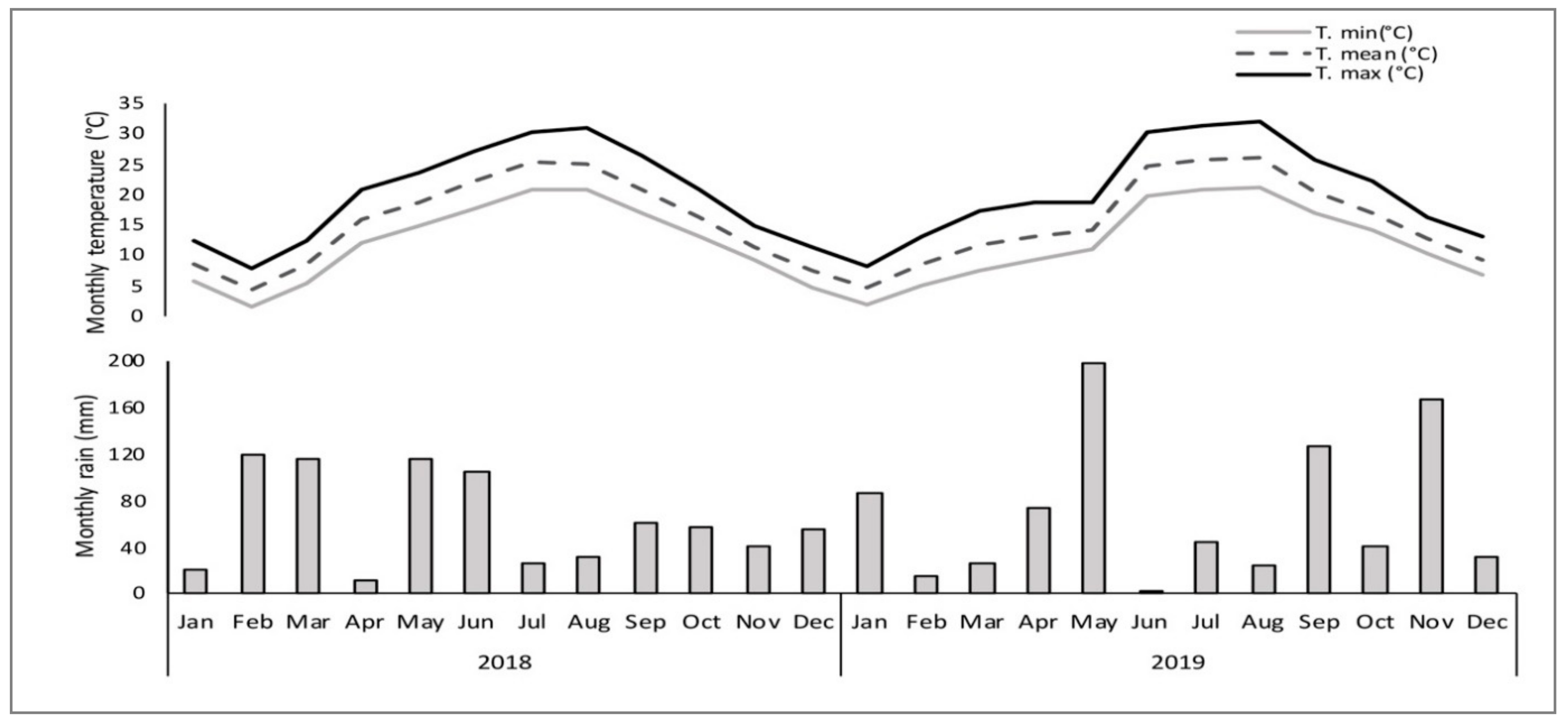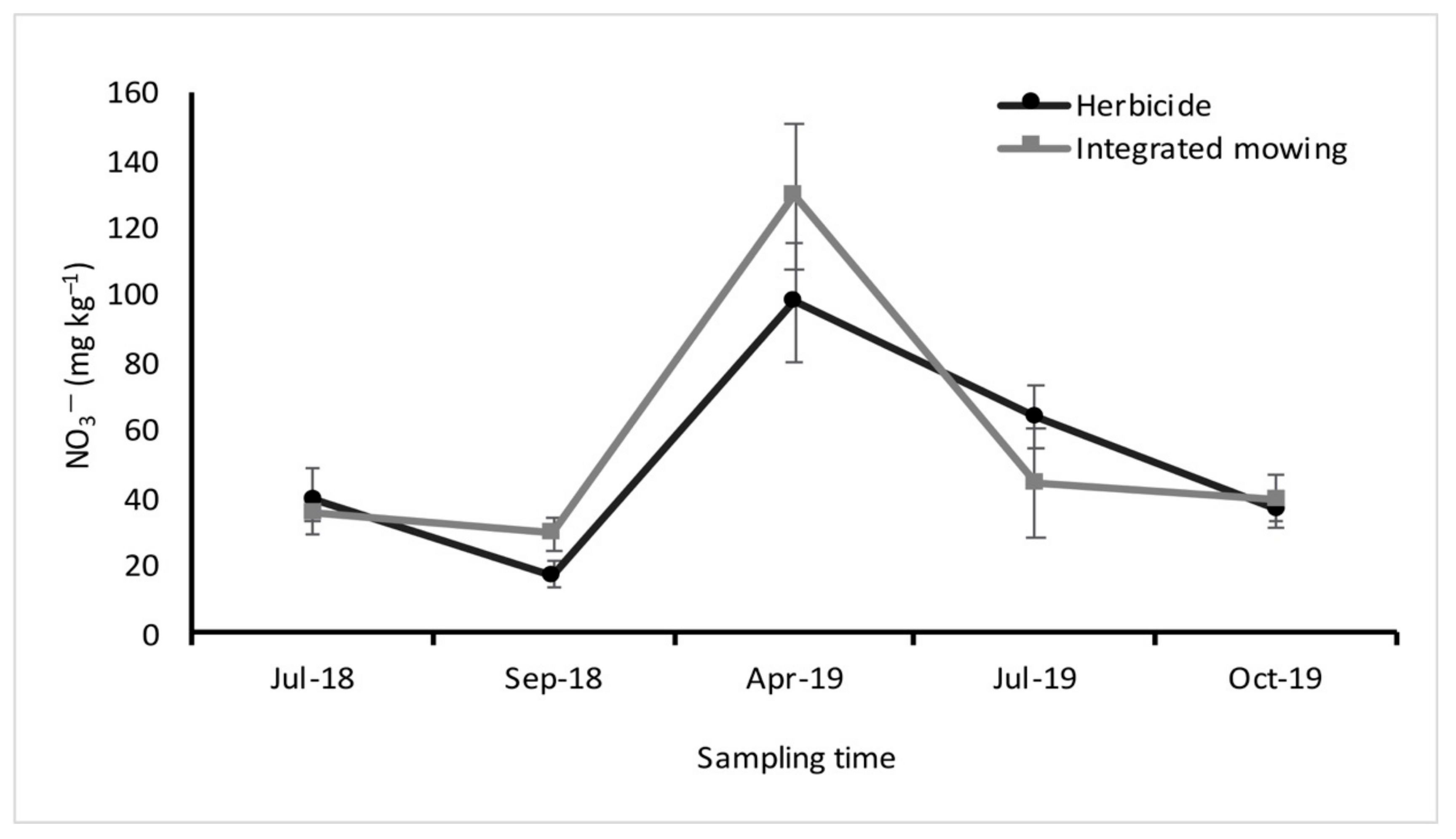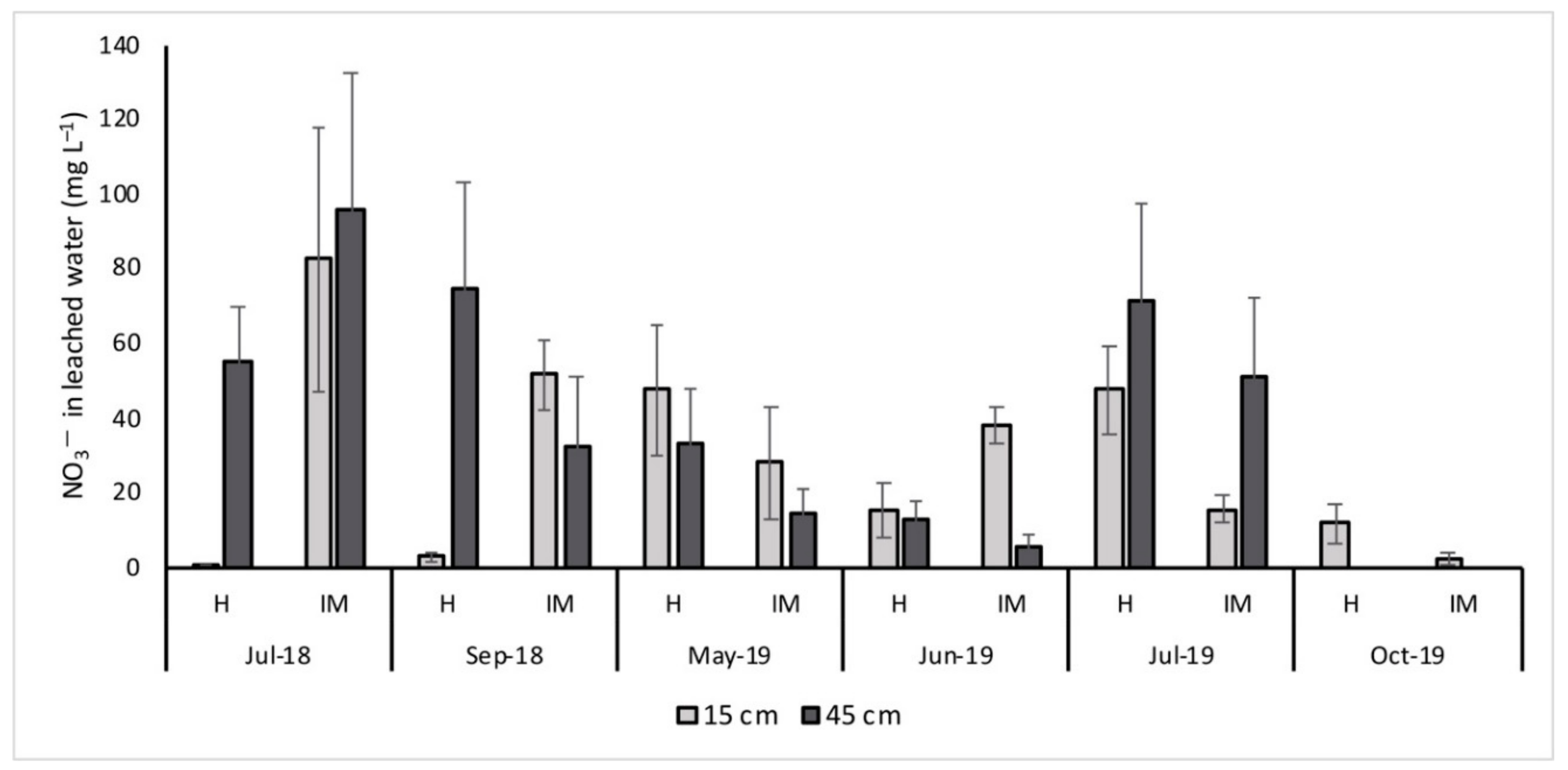Soil Nitrogen and Weed Biodiversity: An Assessment under Two Orchard Floor Management Practices in a Nitrogen Vulnerable Zone in Italy
Abstract
:1. Introduction
2. Materials and Methods
2.1. Site Descriptions, Research Design and Management Practices
2.2. Soil Samples and Analysis
2.3. Weed Biomass and Biodiversity Assessment
2.4. Statistical Analysis
3. Results
3.1. Soil Organic Matter (SOM)
3.2. Soil Nitrogen Status
3.3. Weed Biomass and Species Diversity
4. Discussion
5. Conclusions
Author Contributions
Funding
Acknowledgments
Conflicts of Interest
References
- Geiger, F.; Bengtsson, J.; Berendse, F.; Weisser, W.W.; Emmerson, M.; Morales, M.B.; Ceryngier, P.; Liira, J.; Tscharntke, T.; Winqvist, C.; et al. Persistent negative effects of pesticides on biodiversity and biological control potential on European farmland. Basic Appl. Ecol. 2010, 11, 97–105. [Google Scholar] [CrossRef]
- Mottes, C.; Lesueur-Jannoyer, M.; Bail, M.L.; Malézieux, E. Pesticide transfer models in crop and watershed systems: A review. Agron. Sustain. Dev. 2013, 34, 229–250. [Google Scholar] [CrossRef]
- Zhang, Y.; Wang, L.; Yuan, Y.; Xu, J.; Tu, C.; Fisk, C.; Zhang, W.; Chen, X.; Ritchie, D.; Hu, S. Irrigation and weed control alter soil microbiology and nutrient availability in North Carolina Sandhill peach orchards. Sci. Total Environ. 2018, 615, 517–525. [Google Scholar] [CrossRef]
- García-Pérez, J.; Alarcón-Gutiérrez, E.; Díaz-Fleischer, F. Interactive effect of glyphosate-based herbicides and organic soil layer thickness on growth and reproduction of the tropical earthworm Pontoscolex corethrurus (Müller, 1857). Appl. Soil Ecol. 2020, 155, 103648. [Google Scholar] [CrossRef]
- Mia, J.; Massetani, F.; Murri, G.; Neri, D. Sustainable alternatives to chemicals for weed control in the orchard—A review. Hortic. Sci. 2020, 47, 1–12. [Google Scholar] [CrossRef] [Green Version]
- Neri, D. Organic soil management to prevent soil sickness during integrated fruit production. IOBC WPRS Bull. 2013, 91, 87–99. [Google Scholar]
- Granatstein, D.; Wiman, M.; Kirby, E.; Mullinix, K. Sustainability trade-offs in organic orchard floor management. Acta Hortic. 2010, 873, 115–122. [Google Scholar] [CrossRef]
- Muscas, E.; Cocco, A.; Mercenaro, L.; Cabras, M.; Lentini, A.; Porqueddu, C.; Nieddu, G. Effects of vineyard floor cover crops on grapevine vigor, yield, and fruit quality, and the development of the vine mealybug under a Mediterranean climate. Agric. Ecosyst. Environ. 2017, 237, 203–212. [Google Scholar] [CrossRef]
- Kubota, H.; Quideau, S.A.; Hucl, P.J.; Spaner, D. The effect of weeds on soil arbuscular mycorrhizal fungi and agronomic traits in spring wheat (Triticum aestivumL.) under organic management in Canada. Can. J. Plant Sci. 2015, 95, 615–627. [Google Scholar] [CrossRef]
- Dignac, M.F.; Derrien, D.; Barré, P.; Barot, S.; Cécillon, L.; Chenu, C.; Chevallier, T.; Freschet, G.T.; Garnier, P.; Guenet, B.; et al. Increasing soil carbon storage: Mechanisms, effects of agricultural practices and proxies. A review. Agron. Sustain. Dev. 2017, 37, 14. [Google Scholar] [CrossRef] [Green Version]
- Simon, S.; Jean-Charles, B.; Jean-François, D.; Benoît, S. Review article biodiversity and pest management in orchard systems. A review. Agron. Sustain. Dev. 2010, 30, 139–152. [Google Scholar] [CrossRef] [Green Version]
- Giorgi, V.; Neri, D.; Lodolini, E.M.; Savini, G. Olea europaea L. root growth in soil patches with olive husks and hay residues. Int. J. Fruit Sci. 2008, 7, 19–32. [Google Scholar] [CrossRef]
- Polverigiani, S.; Kelderer, M.; Neri, D. Growth of ‘M9’ apple root in five Central Europe replanted soils. Plant Root 2014, 8, 55–63. [Google Scholar] [CrossRef] [Green Version]
- Endeshaw, S.T.; Lodolini, E.M.; Neri, D. Effects of olive shoot residues on shoot and root growth of potted olive plantlets. Sci. Hortic. 2015, 182, 31–40. [Google Scholar] [CrossRef]
- Vanni, F. The agri-environmental agreement in valdaso (marche). In Agriculture and Public Goods; Springer: Dordrecht, The Netherlands, 2014; pp. 39–51. [Google Scholar] [CrossRef]
- Cui, M.; Zeng, L.; Qin, W.; Feng, J. Measures for reducing nitrate leaching in orchards: A review. Environ. Pollut. 2020, 263, 114553. [Google Scholar] [CrossRef]
- Atucha, A.; Merwin, I.A.; Brown, M.G. Long-term effects of four groundcover management systems in an apple orchard. HortScience 2011, 46, 1176–1183. [Google Scholar] [CrossRef] [Green Version]
- Wang, N.; Wolf, J.; Zhang, F. Towards sustainable intensification of apple production in China—Yield gaps and nutrient use efficiency in apple farming systems. J. Integr. Agric. 2016, 15, 716–725. [Google Scholar] [CrossRef] [Green Version]
- Mia, J.; Massetani, F.; Murri, G.; Facchi, J.; Monaci, E.; Amadio, L.; Neri, D. Integrated weed management in high density fruit orchards. Agronomy 2020, 10, 1492. [Google Scholar] [CrossRef]
- Toderi, M.; Francioni, M.; Seddaiu, G.; Roggero, P.P.; Trozzo, L.; D’Ottavio, P. Bottom-up design process of agri-environmental measures at a landscape scale: Evidence from case studies on biodiversity conservation and water protection. Land Use Policy 2017, 68, 295–305. [Google Scholar] [CrossRef]
- Cui, Z.; Zhang, H.; Chen, X.; Zhang, C.; Ma, W.; Huang, C.; Zhang, W.; Mi, G.; Miao, Y.; Li, X.; et al. Pursuing sustainable productivity with millions of smallholder farmers. Nat. Cell Biol. 2018, 555, 363–366. [Google Scholar] [CrossRef]
- Polverigiani, S.; Franzina, M.; Neri, D. Effect of soil condition on apple root development and plant resilience in intensive orchards. Appl. Soil Ecol. 2018, 123, 787–792. [Google Scholar] [CrossRef]
- Zhang, X.; Davidson, E.A.; Mauzerall, D.L.; Searchinger, T.D.; Dumas, P.; Shen, Y. Managing nitrogen for sustainable development. Nat. Cell Biol. 2015, 528, 51–59. [Google Scholar] [CrossRef] [Green Version]
- Brunetto, G.; Oliveira, B.S.; Ambrosini, V.G.; Couto, R.D.R.; Sete, P.B.; Junior, E.D.S.; Loss, A.; Oliveira-Stefanello, L.; Gatiboni, L.C. Nitrogen availability in an apple orchard with weed management. Ciência Rural 2018, 48. [Google Scholar] [CrossRef]
- Nelson, D.W.; Sommers, L.E. Methods of Soil Analysis: Part 3 Chemical Methods; Book Series No.5; Soil Science Society of America: Madison, WI, USA, 1996; pp. 961–1010. [Google Scholar]
- Mulvaney, R.L. Nitrogen-inorganic forms. SSSA Book Ser. 2018, 3, 1123–1184. [Google Scholar] [CrossRef] [Green Version]
- Braun-Blanquet, J. Pflanƶensoƶiologie; Springer: Berlin, Germany, 1928. [Google Scholar]
- Zoppolo, R.J.; Stefanelli, D.; Bird, G.W.; Perry, R.L. Soil properties under different orchard floor management systems for organic apple production. Org. Agric. 2011, 1, 231–246. [Google Scholar] [CrossRef]
- Wu, J.; Yan, G.; Zhou, G.; Xu, T. Model predictive control of biological nitrogen removal via partial nitrification at low carbon/nitrogen (C/N) ratio. J. Environ. Chem. Eng. 2014, 2, 1899–1906. [Google Scholar] [CrossRef]
- Toselli, M.; Baldi, E.; Cavani, L.; Mazzon, M.; Quartieri, M.; Sorrenti, G.; Marzadori, C.; Moreno, T.; Elena, B.; Luciano, C.; et al. Soil-plant nitrogen pools in nectarine orchard in response to long-term compost application. Sci. Total Environ. 2019, 671, 10–18. [Google Scholar] [CrossRef]
- Ge, S.F.; Xu, H.; Ji, M.; Jiang, Y.M. Characteristics of soil organic carbon, total nitrogen, and C/N ratio in Chinese apple orchards. Open J. Soil Sci. 2013, 3, 213–217. [Google Scholar] [CrossRef] [Green Version]
- Granatstein, D.; Andrews, P.; Groff, A. Productivity, economics, and fruit and soil quality of weed management systems in commercial organic orchards in Washington State, USA. Org. Agric. 2014, 4, 197–207. [Google Scholar] [CrossRef]
- Qiu, K.; Xie, Y.; Xu, D. Ecosystem functions including soil organic carbon, total nitrogen and available potassium are crucial for vegetation recovery. Sci Rep. 2018, 8, 7607. [Google Scholar] [CrossRef]
- Leon, A.; Kohyama, K.; Takata, Y.; Yagi, K.; Umemiya, Y.; Ohkura, T.; Obara, H. Change in soil carbon in response to organic amendments in orchards and tea gardens in Japan. Geoderma 2015, 237, 168–175. [Google Scholar] [CrossRef]
- Vance, E. Agricultural site productivity: Principles derived from long-term experiments and their implications for intensively managed forests. For. Ecol. Manag. 2000, 138, 369–396. [Google Scholar] [CrossRef]
- Dabney, S.M.; Delgado, J.A.; Reeves, D.W. Using winter cover crops to improve soil and water quality. Commun. Soil Sci. Plant Anal. 2001, 32, 1221–1250. [Google Scholar] [CrossRef]
- Carranca, C.; Brunetto, G.; Tagliavini, M. Nitrogen nutrition of fruit trees to reconcile productivity and environmental concerns. Plants 2018, 7, 4. [Google Scholar] [CrossRef] [PubMed] [Green Version]
- Baldi, E.; Quartieri, M.; Muzzi, E.; Noferini, M.; Toselli, M. Use of in situ soil solution electric conductivity to evaluate mineral N in commercial orchards: Preliminary results. Horticulturae 2020, 6, 39. [Google Scholar] [CrossRef]
- Ventura, M.; Scandellari, F.; Ventura, F.; Guzzon, B.; Pisa, P.R.; Tagliavini, M. Nitrogen balance and losses through drainage waters in an agricultural watershed of the Po Valley (Italy). Eur. J. Agron. 2008, 29, 108–115. [Google Scholar] [CrossRef]
- Demestihas, C.; Plénet, D.; Génard, M.; Raynal, C.; Lescourret, F. Ecosystem services in orchards. A review. Agron. Sustain. Dev. 2017, 37, 12. [Google Scholar] [CrossRef]
- Bàrberi, P.; Bocci, G.; Carlesi, S.; Armengot, L.; Blanco-Moreno, J.M.; Sans, F.X. Linking species traits to agroecosystem services: A functional analysis of weed communities. Weed Res. 2018, 58, 76–88. [Google Scholar] [CrossRef]





| Parameters | NO3− (mg kg−1) | NH4+ (mg kg−1) | Mineral N (mg kg−1) | Organic N (g kg−1) | Total N (g kg−1) | SOM (%) |
|---|---|---|---|---|---|---|
| Orchard (O) | ||||||
| Apple | 58.2 | 10.5 | 68.7 | 1.25 a z | 1.32 a | 1.62 a |
| Peach | 48.8 | 11.8 | 60.7 | 1.09 b | 1.15 b | 1.27 b |
| p-value | 0.068 | 0.301 | 0.149 | 0.0001 | 0.0001 | 0.0001 |
| Treatment (T) | ||||||
| Herbicide | 51.30 | 10.98 | 58.5 | 1.18 | 1.23 | 1.44 |
| Integrated mowing | 55.75 | 11.31 | 62.8 | 1.17 | 1.24 | 1.45 |
| p-value | 0.385 | 0.800 | 0.387 | 0.898 | 0.916 | 0.892 |
| Soil depth (SD) | ||||||
| 0–20 cm | 67.68 a | 12.51 | 75.3 a | 1.26 a | 1.34 a | 1.61 a |
| 20–40 cm | 39.36 b | 9.78 | 46 b | 1.08 b | 1.13 b | 1.28 b |
| p-value | 0.0001 | 0.407 | 0.0001 | 0.0001 | 0.0001 | 0.0001 |
| Sampling time (ST) | ||||||
| 18 July | 37.7 bc | 17.33 a | 53.1 b | 1.13 b | 1.18 c | 1.60 a |
| 18 September | 23.5 c | 8.95 bc | 24 c | 0.98 c | 1.01 d | 1.32 b |
| 19 April | 113.8 a | 14.08 ab | 148 a | 1.18 b | 1.30 b | 1.24 b |
| 19 July | 54.3 b | 6.75 c | 40.6 bc | 1.38 a | 1.44 a | 1.46 ab |
| 19 October | 38.4 bc | 8.62 bc | 37.5 bc | 1.19 b | 1.24 bc | 1.60 a |
| p-value | 0.0001 | 0.0001 | 0.0001 | 0.0001 | 0.0001 | 0.0001 |
| Interaction (p-value) | ||||||
| O × T | 0.914 | 0.919 | 0.93 | 0.083 | 0.08 | 0.32 |
| O × SD | 0.0001 | 0.544 | 0.78 | 0.834 | 0.55 | 0.85 |
| O×ST | 0.0001 | 0.0333 | 0.0003 | 0.089 | 0.103 | 0.07 |
| T × SD | 0.0622 | 0.199 | 0.0408 | 0.385 | 0.198 | 0.26 |
| T × ST | 0.0306 | 0.995 | 0.0762 | 0.293 | 0.6250 | 0.86 |
| SD × ST | 0.0001 | 0.442 | 0.0001 | 0.290 | 0.9017 | 0.68 |
| O × T × SD | 0.40 | 0.1139 | 0.244 | 0.680 | 0.916 | 0.4313 |
| O × T × ST | 0.4796 | 0.969 | 0.59 | 0.168 | 0.1820 | 0.194 |
| O × SD × ST | 0.0001 | 0.994 | 0.0001 | 0.678 | 0.944 | 0.915 |
| T × SD × ST | 0.08 | 0.203 | 0.185 | 0.964 | 0.96 | 0.88 |
| O × ST × SD × T | 0.120 | 0.0884 | 0.095 | 0.928 | 0.955 | 0.91 |
| Parameters | Soil Cover (%) | Weed Species Number (n) | Dry Weed Biomass (g/m2) |
|---|---|---|---|
| Orchard (O) | |||
| Apple | 68.3 | 4.9 | 97.0 |
| Peach | 56.9 | 4.2 | 95.2 |
| p-value | 0.063 | 0.138 | 0.060 |
| Treatment (T) | |||
| Herbicide | 32.9 b Z | 2.2 b | 55.5 b |
| Integrated mowing | 92.3 a | 7.0 a | 137 a |
| p-value | 0.0001 | 0.0001 | 0.0001 |
| Year (Y) | |||
| 2018 | 58.3 | 5.5 a | 131.7 a |
| 2019 | 66.9 | 3.7 b | 69.0 b |
| p-value | 0.1654 | 0.0004 | 0.0001 |
| Interaction (p-value) | |||
| O × T | 0.972 | 0.381 | 0.438 |
| O × Y | 0.040 | 0.019 | 0.0001 |
| T × Y | 0.396 | 0.930 | 0.988 |
| O × T × Y | 0.610 | 0.38 | 0.264 |
Publisher’s Note: MDPI stays neutral with regard to jurisdictional claims in published maps and institutional affiliations. |
© 2020 by the authors. Licensee MDPI, Basel, Switzerland. This article is an open access article distributed under the terms and conditions of the Creative Commons Attribution (CC BY) license (http://creativecommons.org/licenses/by/4.0/).
Share and Cite
Mia, M.J.; Monaci, E.; Murri, G.; Massetani, F.; Facchi, J.; Neri, D. Soil Nitrogen and Weed Biodiversity: An Assessment under Two Orchard Floor Management Practices in a Nitrogen Vulnerable Zone in Italy. Horticulturae 2020, 6, 96. https://doi.org/10.3390/horticulturae6040096
Mia MJ, Monaci E, Murri G, Massetani F, Facchi J, Neri D. Soil Nitrogen and Weed Biodiversity: An Assessment under Two Orchard Floor Management Practices in a Nitrogen Vulnerable Zone in Italy. Horticulturae. 2020; 6(4):96. https://doi.org/10.3390/horticulturae6040096
Chicago/Turabian StyleMia, Md Jebu, Elga Monaci, Giorgio Murri, Francesca Massetani, Jacopo Facchi, and Davide Neri. 2020. "Soil Nitrogen and Weed Biodiversity: An Assessment under Two Orchard Floor Management Practices in a Nitrogen Vulnerable Zone in Italy" Horticulturae 6, no. 4: 96. https://doi.org/10.3390/horticulturae6040096






